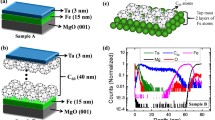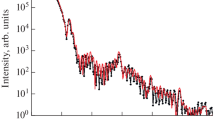Abstract
Organic spintronics has emerged as a promising field for exploring novel spin-based phenomena and devices, offering the potential for low-power, flexible, and biocompatible electronics. The interface between metallic ferromagnetic and semiconducting organic layers plays a pivotal role in spin injection, transport, and extraction processes in these devices. Therefore, achieving a comprehensive understanding of the magnetic properties at these interfaces is essential for advancing device performance and functionality. This work explores the magnetic properties at the interface between thin Fe film and the C60 layer. We employ a multi-technique approach, combining the magneto-optic Kerr effect, which provides a global assessment of magnetic properties, and depth-resolved grazing incidence nuclear resonance scattering (GINRS) under X-ray standing wave conditions, enabling us to probe magnetism with high spatial resolution within the interfacial region. GINRS measurements reveal intriguing behavior at the interface, characterized by reduced hyperfine fields in diffused 57Fe layers. This observation suggests the formation of superparamagnetic clusters, which significantly influence the magnetic properties at the interface. These findings provide valuable insights into the complex interplay between ferromagnetic materials and organic semiconductors at the nanoscale, offering potential avenues for tailoring magnetoresistance effects in organic spintronic devices and contributing to the fundamental understanding of spin-dependent phenomena in organic spintronics.






Similar content being viewed by others
Data Availability
No datasets were generated or analysed during the current study.
References
Hirohata, A., Takanashi, K.: Future perspectives for spintronic devices. J. Phys. D Appl. Phys. 47(19), 193001 (2014). https://doi.org/10.1088/0022-3727/47/19/193001
Hirohata, A., et al.: Review on spintronics: principles and device applications. J. Magn. Magn. Mater. 509, 166711 (2020). https://doi.org/10.1016/j.jmmm.2020.166711
Datta, D., Kumar, S.: Growth and ellipsometric studies on C60 thin films for solar cell applications. J. Appl. Phys. 106(7), 074517 (2009). https://doi.org/10.1063/1.3239853
Pathak, D., et al.: New tailored organic semiconductors thin films for optoelectronic applications. Eur. Phys. J. Appl. Phys. 95(1), (2021).https://doi.org/10.1051/epjap/2021210090
Reineke, S., Thomschke, M., Lüssem, B., Leo, K.: White organic light-emitting diodes: status and perspective. Rev. Mod. Phys. 85(3), 1245–1293 (2013). https://doi.org/10.1103/RevModPhys.85.1245
Sanvito, S.: The rise of spinterface science. Nature Phys. 6(8), (2010). https://doi.org/10.1038/nphys1714
Nguyen, T.D., Wang, F., Li, X.-G., Ehrenfreund, E., Vardeny, Z.V.: Spin diffusion in fullerene-based devices: morphology effect. Phys. Rev. B 87(7), 075205 (2013). https://doi.org/10.1103/PhysRevB.87.075205
Zhang, X., et al.: Observation of a large spin-dependent transport length in organic spin valves at room temperature. Nat Commun. 4(1),(2013). https://doi.org/10.1038/ncomms2423
Dediu, V.A., Hueso, LE., Bergenti, I., Taliani, C.: Spin routes in organic semiconductors. Nature Mater. 8(9), (2009). https://doi.org/10.1038/nmat2510
Sun, D.-L., Ehrenfreund, E.: The first decade of organic spintronics research. Chemical communications (Cambridge, England). 50, (2014). https://doi.org/10.1039/c3cc47126h
Li, D., Yu, G.: Innovation of materials, devices, and functionalized interfaces in organic spintronics. Adv. Func. Mater. 31(28), 2100550 (2021). https://doi.org/10.1002/adfm.202100550
Steil, S., et al.: Spin-dependent trapping of electrons at spinterfaces. Nature Phys. 9(4), (2013). https://doi.org/10.1038/nphys2548
Moorsom, T., et al.: Reversible spin storage in metal oxide—fullerene heterojunctions. Science Advance. 6(12), eaax1085 (2020). https://doi.org/10.1126/sciadv.aax1085
Droghetti, A., et al.: Dynamic spin filtering at the Co/Alq3 interface mediated by weakly coupled second layer molecules. Nat Commun. 7(1), (2016). https://doi.org/10.1038/ncomms12668
Moorsom, T., et al.: Spin-polarized electron transfer in ferromagnet/C60 interfaces. Phys. Rev. B 90(12), 125311 (2014). https://doi.org/10.1103/PhysRevB.90.125311
Bairagi, K., et al.: Experimental and theoretical investigations of magnetic anisotropy and magnetic hardening at molecule/ferromagnet interfaces. Phys. Rev. B 98(8), 085432 (2018). https://doi.org/10.1103/PhysRevB.98.085432
Bairagi, K., et al.: Tuning the magnetic anisotropy at a molecule-metal interface. Phys. Rev. Lett. 114(24), 247203 (2015). https://doi.org/10.1103/PhysRevLett.114.247203
Mallik, S., Sharangi, P., Sahoo, B., Mattauch, S., Brückel, T., Bedanta, S.: Enhanced anisotropy and study of magnetization reversal in Co / C 60 bilayer thin film. Appl. Phys. Lett. 115(24), 242405 (2019). https://doi.org/10.1063/1.5096879
Sharangi, P., et al.: Effect of fullerene on anisotropy, domain size and relaxation in a perpendicularly magnetized Pt/Co/C 60 /Pt system. Journal of Materials Chemistry C (2022). https://doi.org/10.1039/D2TC01347A
Mallik, S., Mattauch, S., Dalai, M. K., Brückel, T., Bedanta, S.: Effect of magnetic fullerene on magnetization reversal created at the Fe/C60 interface. Sci Rep. 8(1), (2018). https://doi.org/10.1038/s41598-018-23864-8
Mondal, K.P., et al.: Effect of growth rate on quality of Alq3 films and Co diffusion. J. Phys. D Appl. Phys. 54(15), 155304 (2021). https://doi.org/10.1088/1361-6463/abd9eb
Kaushik, S., et al.: Study of obliquely deposited 57Fe layer on organic semiconductor (Alq3); interface resolved magnetism under x-ray standing wave. Hyperfine Interact. 242(1), 24 (2021). https://doi.org/10.1007/s10751-021-01756-0
Khanderao, A.G., et al.: Interface magnetism in Fe/Alq3 bilayer; interface resolved nuclear resonance scattering studies. J. Magn. Magn. Mater. 560, 169663 (2022). https://doi.org/10.1016/j.jmmm.2022.169663
Chan, Y.-L., et al.: Magnetic response of an ultrathin cobalt film in contact with an organic pentacene layer. Phys. Rev. Lett. 104(17), 177204 (2010). https://doi.org/10.1103/PhysRevLett.104.177204
Chen, B. B., Zhou, Y., Wang, S., Shi, Y. J., Ding, H. F., Wu, D.: Giant magnetoresistance enhancement at room-temperature in organic spin valves based on La0.67Sr0.33MnO3 electrodes. Appl. Phys. Lett. 103(7), 072402 (2013). https://doi.org/10.1063/1.4818614
Dediu, V., et al.: Room-temperature spintronic effects in Alq3-based hybrid devices. Phys. Rev. B 78(11), 115203 (2008). https://doi.org/10.1103/PhysRevB.78.115203
Xiong, Z. H., Wu, D., Valy Vardeny, Z., Shi, J.: Giant magnetoresistance in organic spin-valves. Nature. 427(6977), (2004)
Gobbi, M., Golmar, F., Llopis, R., Casanova, F., Hueso, L.E.: Room-temperature spin transport in C60-based spin valves. Adv. Mater. 23(14), 1609–1613 (2011). https://doi.org/10.1002/adma.201004672
Barraud, C., et al.: Unravelling the role of the interface for spin injection into organic semiconductors. Nature Phys. 6(8), (2010). https://doi.org/10.1038/nphys1688
Hsu, C.-C., Hsu, K.-L., Chang, P.-C., Liu, S.-Y., Hsu, C.-C., Lin, W.-C.: Organic/metal interface–modulated magnetism in [Fe/C60]3 multilayers and Fe-C60 composites. Nanotechnology 31(32), 325701 (2020)
Tsoy, G., Janu, Z., Novak, M., Soukup, F., Tichy, R.: High-resolution SQUID magnetometer. Physica B 284–288, 2122–2123 (2000). https://doi.org/10.1016/S0921-4526(99)03023-9
Kaushik, S., Khanderao, A. G., Gupta, P., Raghavendra Reddy, V., Kumar, D.: Growth of ultra-thin cobalt on fullerene (C60) thin-film: in-situ investigation under UHV conditions. Mater. Sci. Eng. B. 284, 115911 (2022). https://doi.org/10.1016/j.mseb.2022.115911
Kumar, D., et al.: Interface induced perpendicular magnetic anisotropy in a Co/CoO/Co thin-film structure: an in situ MOKE investigation. J. Phys. D Appl. Phys. 47(10), 105002 (2014). https://doi.org/10.1088/0022-3727/47/10/105002
Won, S., Saun, S.-B., Lee, S., Lee, S., Kim, K., Han, Y.: NMR spectroscopy for thin films by magnetic resonance force microscopy. Sci Rep. 3(1), (2013). https://doi.org/10.1038/srep03189
Raj, R., Kuila, M., Gupta, M., Reddy, V.: 57Fe Mössbauer and magneto-optical Kerr effect (MOKE) study of transcritical state in permalloy (FexNi100-x) thin films. Hyperfine Interactions. 242, (2021). https://doi.org/10.1007/s10751-021-01753-3
Perry, L.K., Ryan, D.H., Gagnon, R.: Studying surfaces and thin films using Mössbauer spectroscopy. Hyperfine Interact. 170(1), 131–143 (2006). https://doi.org/10.1007/s10751-006-9463-6
Gellert, R., et al.: Depth selective CEMS in the energy range 0 to 20 keV. Nucl. Instrum. Methods Phys. Res., Sect. B 76(1), 381–382 (1993). https://doi.org/10.1016/0168-583X(93)95246-2
Couet, S., et al.: The magnetic structure of coupled Fe/FeO multilayers revealed by nuclear resonant and neutron scattering methods. New J. Phys. 11(1), 013038 (2009). https://doi.org/10.1088/1367-2630/11/1/013038
Stöhr, J., Padmore, H.A., Anders, S., Stammler, T., Scheinfein, M.R.: Principles of X-ray magnetic dichroism spectromicroscopy. Surf. Rev. Lett. 05(06), 1297–1308 (1998). https://doi.org/10.1142/S0218625X98001638
Liu, Y., et al.: Correlation between microstructure and magnetotransport in organic semiconductor spin-valve structures. Phys. Rev. B 79(7), 075312 (2009). https://doi.org/10.1103/PhysRevB.79.075312
Wang, Y.-P., Han, X.-F., Fry, J.N., Krause, J.L., Zhang, X.-G., Cheng, H.-P.: Deposition of cobalt atoms onto Alq3 films: a molecular dynamics study. Phys. Rev. B 90(7), 075311 (2014). https://doi.org/10.1103/PhysRevB.90.075311
Jamal, M., Gupta, P., Raj, R., Gupta, M., Reddy, V., Kumar, D.: Structural and magnetic asymmetry at the interfaces of MgO/FeCoB/MgO trilayer: precise study under x-ray standing wave conditions. J. Appl. Phys. 131, 235301 (2022). https://doi.org/10.1063/5.0092977
Khanderao, A.G., Sergueev, I., Wille, H.C., Kumar, D.: Interface resolved magnetism at metal–organic (Fe/Alq3) interfaces under x-ray standing wave condition. Appl. Phys. Lett. 116(10), 101603 (2020). https://doi.org/10.1063/1.5135361
Andreeva, M., et al.: Evolution of the magnetic hyperfine field profiles in an ion-irradiated Fe60Al40 film measured by nuclear resonant reflectivity. J Synchrotron Rad. 28(5), (2021). https://doi.org/10.1107/S1600577521007694
Schlage, K., Röhlsberger, R.: Nuclear resonant scattering of synchrotron radiation: Applications in magnetism of layered structures. J. Electron Spectrosc. Relat. Phenom. 189, 187–195 (2013). https://doi.org/10.1016/j.elspec.2013.02.005
Singh, M., et al.: Depth selective local coordination in CoFeB thin films probed by XAFS and ToF-SIMS. J. Alloy. Compd. 960, 170588 (2023). https://doi.org/10.1016/j.jallcom.2023.170588
Abruna, H. D., Bommarito, G. M., Yee, H. S.: X-ray standing waves and surface EXAFS studies of electrochemical interfaces. CS Publications. Accessed 30 Dec 2023. [Online]. Available: https://pubs.acs.org/doi/pdf/10.1021/ar00054a005
Jamal, Md.S., Gupta, P., Sergeev, I., Leupold, O., Kumar, D.: Interface-resolved study of magnetism in MgO/FeCoB/MgO trilayers using x-ray standing wave techniques. Phys. Rev. B 107(7), 075416 (2023). https://doi.org/10.1103/PhysRevB.107.075416
Andreeva, M.A.: Nuclear resonant reflectivity data evaluation with the “REFTIM” program. Hyperfine Interact. 185(1–3), 17–21 (2008). https://doi.org/10.1007/s10751-008-9806-6
Roth, T.A.: The surface and grain boundary energies of iron, cobalt and nickel. Mater. Sci. Eng. 18(2), 183–192 (1975). https://doi.org/10.1016/0025-5416(75)90168-8
Ma, X., Wigington, B., Bouchard, D.: Fullerene C60: surface energy and interfacial interactions in aqueous systems. Langmuir 26(14), 11886–11893 (2010). https://doi.org/10.1021/la101109h
Kaune, G., et al.: In situ GISAXS study of gold film growth on conducting polymer films. ACS Appl. Mater. Interfaces 1(2), 353–360 (2009). https://doi.org/10.1021/am8000727
Morkved, T.L., Wiltzius, P., Jaeger, H.M., Grier, D.G., Witten, T.A.: Mesoscopic self-assembly of gold islands on diblock-copolymer films. Appl. Phys. Lett. 64(4), 422–424 (1994). https://doi.org/10.1063/1.111118
Funding
Partial financial support from the Department of Science and Technology (Government of India) (Project-CRG/2021/003094) is gratefully acknowledged.
Author information
Authors and Affiliations
Contributions
S.K.: Data curation (lead); Formal analysis (lead); Investigation (lead); Methodology (lead); Validation (lead); Writing – original draft (lead); Writing – review & editing (lead). R.R.: Data curation (supporting); Writing – review & editing (equal). I.S.: Data curation (supporting); Resources P.G.: Resources V.R.R. : Resources D.K.: Conceptualization; Resources; Validation (equal); Writing – review & editing (equal).
Corresponding author
Ethics declarations
Competing Interests
The authors declare no competing interests.
Additional information
Publisher's Note
Springer Nature remains neutral with regard to jurisdictional claims in published maps and institutional affiliations.
Rights and permissions
Springer Nature or its licensor (e.g. a society or other partner) holds exclusive rights to this article under a publishing agreement with the author(s) or other rightsholder(s); author self-archiving of the accepted manuscript version of this article is solely governed by the terms of such publishing agreement and applicable law.
About this article
Cite this article
Kaushik, S., Raj, R., Sergeev, I. et al. Depth Resolved Magnetic Studies of Fe/57Fe/C60 Bilayer Structure Under X-Ray Standing Wave Condition. J Supercond Nov Magn (2024). https://doi.org/10.1007/s10948-024-06738-1
Received:
Accepted:
Published:
DOI: https://doi.org/10.1007/s10948-024-06738-1




